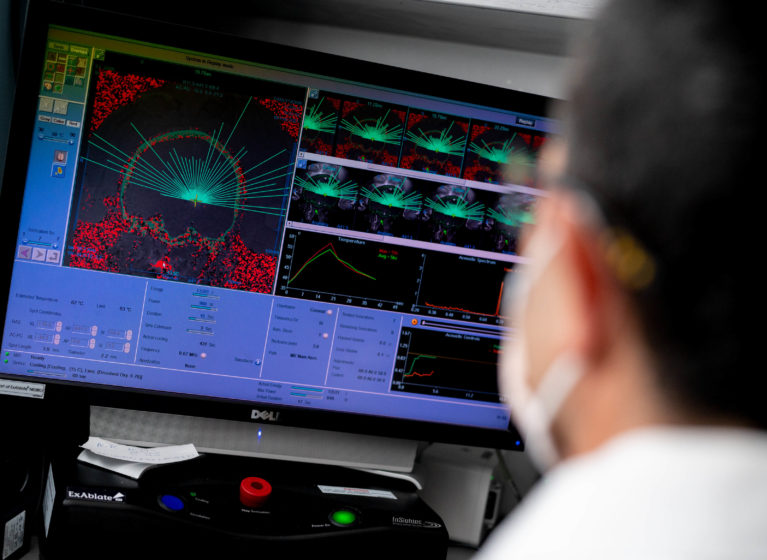
At a Glance
- UVA researchers discovered a novel oncogene responsible for glioblastoma.
- Identifying the oncogene, AVIL, is a huge step forward in creating a targeted treatment for this deadly cancer.
- UVA is investigating the use of focused ultrasound combined with a sonosensitizing drug to make tumor cells susceptible to sound waves.
- UVA is using focused ultrasound to open the blood-brain barrier to deliver treatments directly to the brain in a way never before possible.
An Achilles’ Heel for Glioblastoma
Researchers at UVA School of Medicine and UVA Cancer Center have identified an oncogene responsible for glioblastoma, the deadliest brain tumor. The discovery offers a promising new treatment target for a cancer that is inevitably fatal.
The researchers say the oncogene is essential to the survival of the cancer cells. Without it, the cancer cells die. Scientists have already developed many targeted therapies for other cancers with a similar “oncogene addiction.”
“Glioblastoma is one of the most deadly cancers. Unfortunately, there is no effective treatment option for the disease. The current standard option — radiation plus temozolomide, which displayed a 2.5-month better survival rate — was hailed as a great success. Clearly, better understanding and new therapeutic targets are urgently needed,” says UVA researcher Hui Li, PhD. “The novel oncogene we discovered promises to be an Achilles’ heel of glioblastoma.”
Silencing the Oncogene
The specific oncogene, AVIL, occurs normally, helping cells retain size and shape. Thrown into overdrive by a variety of factors, AVIL can spiral out of control and cause cancer.
Blocking the gene’s activity completely destroyed glioblastoma cells in lab mice, but had no effect on healthy cells. This suggests targeting the gene could be an effective treatment option.
“AVIL is overexpressed in 100% of glioblastoma cells and clinical samples. It is expressed at an even higher level in so-called glioblastoma stem cells, but hardly expressed in normal cells and tissues,” says Li. “Silencing the gene wiped out glioblastoma cells in culture and prevented animal xenografts, while having no effect on normal control cells. Clinically, high AVIL expression correlates with worse patient outcome. These findings and classic transformation assays proved AVIL is a bona fide oncogene.”
Childhood Cancers: Path to Discovery
Li and his team weren’t even working on glioblastoma when they first caught the scent that led to the discovery. Instead, they were studying a rare childhood cancer called rhabdomyosarcoma. (Childhood cancers typically are easier to understand and involve fewer mutations than adult cancers.)
During their research, the scientists discovered an abnormality in the AVIL gene. That prompted them to examine adult cancers to see if the gene could be contributing there. And, it was. The researchers concluded the gene plays a “critical role” in glioblastoma, they report in a scientific paper outlining their findings.
Li and his team believe their approach can be used to discover other oncogenes — hopefully leading to new treatments for a variety of cancers.
“In this day and age, many people thought that all the significant oncogenes had been discovered. Here, we uncovered a novel, powerful oncogene and elucidated its signaling pathways, all starting from studying a structure variant in a pediatric cancer. In the past, numerous significant discoveries in cancer also stemmed from studying pediatric tumors,” Li says. “We believe this strategy can be applied to find novel players in other adult cancers.”
The Promise of Focused Ultrasound for Brain Tumors
Li’s work is part of an ambitious research campaign at UVA Health to better understand and better treat glioblastoma. For example, UVA neurosurgeon Jason Sheehan, MD, PhD, is investigating focused ultrasound as a potential treatment approach. He combines the minimally invasive technology with a sonosensitizing drug that makes tumor cells susceptible to sound waves. In a recent publication, he and his collaborators concluded that the technique has “substantial potential for treatment of malignant brain tumors and other challenging oncology indications,” such as breast cancer, lung cancer, and melanoma.
“Sonodynamic therapy with focused ultrasound offers a new therapeutic approach to treating patients with malignant brain tumors,” Sheehan says. “This approach combines two approved options, [the drug] 5-ALA and focused ultrasound, to produce a powerful tumoricidal effect on several different types of glioblastomas. We are also exploring sonodynamic therapy for the treatment of metastatic cancer to the brain.”
Meanwhile, Richard J. Price, PhD, a biomedical engineer and director at UVA Focused Ultrasound Center, is exploring the potential of focused ultrasound to open the blood-brain barrier to deliver cutting-edge treatments directly to the brain in a way never before possible.
“With MRI, we first identify the target, whether it’s a brain tumor or maybe a part of the brain to which we wish to target gene therapy. We then develop a treatment plan that will open the [blood-brain] barrier only in our targeted region. All other regions of the brain are left completely untouched,” says Price. “When we apply the focused ultrasound, it opens the barrier at the target site for a few hours. It allows us to get the gene therapy across, and then the barrier closes naturally.”
UVA recently treated the first glioblastoma patient as part of a multicenter clinical trial evaluating the safety of using low-dose focused ultrasound to temporarily open the blood-brain barrier to enhance the delivery of chemotherapy, allowing it to enter the brain at higher concentrations and more precisely target the tumor site. Led by Sheehan, this study is now actively recruiting patients.
Learn more about the clinical trial for glioblastoma under way at UVA.